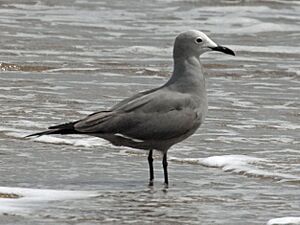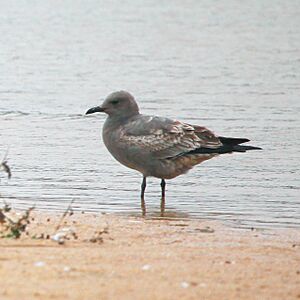Grey gull facts for kids
Quick facts for kids Grey gull |
|
|---|---|
 |
|
| Grey gull at La Laguna, Chile | |
 |
|
| A young grey gull at Algarrobo, Valparaíso Region, Chile | |
| Conservation status | |
| Scientific classification | |
| Genus: |
Leucophaeus
|
| Species: |
modestus
|
 |
|
| Synonyms | |
|
Larus modestus |
|
The grey gull, also known as the garuma gull, is a medium-sized gull bird. Its scientific name is Leucophaeus modestus. This special bird lives in South America.
What makes it unusual is where it builds its nests. Most gulls nest near the sea. But the grey gull breeds far inland in the very dry Atacama Desert in northern Chile. When it's not breeding, you can find it along the Pacific coast of South America.
Contents
What Does the Grey Gull Look Like?
Male and female grey gulls look very similar. An adult grey gull grows to be about 45 cm long. It weighs around 360 to 400 g.
In summer, its head is white. But in winter, it turns brownish-grey. Its body and wings are grey. The back is a bit darker than its belly.
The long flight feathers on its wings are black. The inner wing feathers and the secondary feathers have white tips. You can see these white tips when the bird is flying. Its tail has a black band with a white edge. The legs and beak are black, and its eyes are brown. The sound it makes is like the laughing gull.
Where Do Grey Gulls Live?
The grey gull nests in the Atacama Desert in northern Chile. This desert is very dry and hot.
When they are not breeding, these gulls live in many places. You can find them along the coasts of Ecuador, Peru, and south-central Chile. Sometimes, they have been seen in the Falkland Islands and South Georgia. They have also visited Mexico, the Galapagos Islands, Guatemala, Brazil, Argentina, Panama, and Florida.
How Do Grey Gulls Behave?
Grey Gull Life Cycle
For many years, no one knew where grey gulls laid their eggs. Scientists couldn't find any nests near the coast. Then, in 1945, they made an amazing discovery! They found that these gulls nest in the Atacama Desert in Chile.
This hot, dry desert might seem like a strange place for a bird to nest. But it has very few animals that would try to eat the eggs or chicks. This makes it a safe place for the gulls to raise their young.
The gulls make a simple nest. It's just a shallow dip in the sand, often near rocks. These nesting spots are far from the ocean, about 35 to 100 km away. Once the eggs hatch, the parent gulls take turns. They fly all the way to the sea and back. They bring food and water for their babies.
The desert weather changes a lot each day. It can be humid, windy, and temperatures can swing wildly. The parent gull has ways to keep itself, its eggs, and its chicks at the right temperature. When it's very hot, the parent stands over the nest. This shades the eggs or chicks from the sun.
A main predator of the grey gull is the turkey vulture. If a vulture comes near, the parent might leave the nest for a short time. When this happens, the eggs need to be strong. Their shells are special. They don't lose too much water through evaporation. This helps the eggs survive in the dry desert.
What Do Grey Gulls Eat?
Grey gulls usually live on sandy beaches and muddy areas. These are found along the western coasts of South America. They use their beaks to search in the sand for small animals. They especially like mole crabs.
They also eat fish and ragworms. Sometimes, they eat scraps of food left behind by others. They might even follow fishing boats to find food.
Are Grey Gulls Endangered?
The grey gull nests in a specific area inland. Its winter home is also limited to the coasts of Ecuador, Peru, and Chile. The number of grey gulls seems to be slowly decreasing.
However, there are still many grey gulls in total. Because of this, they are listed as a species of "least concern". This means they are not currently in danger of disappearing.


